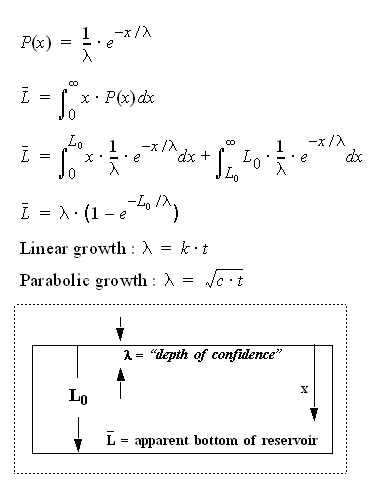Dispersion Fits
The same dispersion that fits into the dispersive discovery model and reserve growth gives the climate change deniers a different type of fits.
I looked at Wharf Rat's analysis and it features some relatively straightforward assumptions.
In general I think the standard premise of "dispersion" of time constants in climate change has the same validity on oil depletion analysis. Not only does dispersion play an effect on discovery profiles and reserve growth, but it also plays a key role in the log-normal distribution of reservoir sizes1. For climate change, remember that not one single time constant rules over the temperature time series that the data analysts pour over. Interestingly, the dispersion has positive effects on oil resources, in that it leads to greater reserves than we may currently believe, but the same effect has negative consequence as the longer time scales in GW analysis lead to lags in heating that deniers such as Steven Schwartz evidently miss completely, and non-skeptical sorts like jrwakefield (a troll commenter on TOD) gobble up.
The deniers don't understand the math and it gives them fits.
1 The USGS analysts that did the following study on crystal growth mechanisms may or may not know that their analysis has a strong analogy to reservoir growth. Millions of years ago, the dispersion in growth rates of primordial reservoirs caused the log-normal distribution of discovery sizes we see today. The math shakes out rather straightforwardly and I will try to show a derivation in the near future.
The evolution of the shape of a crystal size distribution (CSD) can be used to infer growth laws for crystals. For example, the often assumed constant growth rate law (dX/dt=k, where X is crystal diameter, t is time, and k is a constant) is unrealistic in most systems because it causes the variance of the CSD to approach 0 during growth, and because it destroys the shape of commonly occurring lognormal CSDs. Conversely, proportionate growth models (dX/dt=kX) best describe the evolution of CSDs in most systems. This law can be derived from a modified version of the Law of Proportionate Effect (LPE: X(j+1)=X(j) + v(j)e(j)X(j), where j refers to the growth cycle or time interval, v is a function of the proportion of the total volume of material available for each crystal for each growth cycle, and e is a random number that varies between 0 and 1). When v is large with respect to X, as is the case immediately after nucleation, the variance of the CSD increases with mean diameter and a lognormal CSD results. However, as X grows larger with respect to v, the variance remains constant as the mean crystal diameter increases, and the proportionate growth law is approximated. Simulating crystal growth by LPE using the Galoper computer program leads to some surprising conclusions, several of which have been confirmed by experiment: (1) If a small crystal doubles in diameter, a large crystal in the same system also will tend to double in diameter during the same time interval, even though such growth involves adding much more volume to the larger crystal; (2) Crystal growth has a random component (e), which indicates that one can not predict accurately the growth rate for individual crystals, but only for the distribution of crystals. This inherent randomness also accounts for crystal growth dispersion; (3) The relative shape of a CSD generally is determined soon after nucleation, and then is maintained during proportionate growth; (4) Crystal growth appears to occur in nanometer-size jumps, rather than continuously with time; and, (5) Proportionate growth occurs when reactants are supplied to the crystal surface by advection under stirred conditions, whereas constant growth is favored when supply is by diffusion under stagnant conditions.













